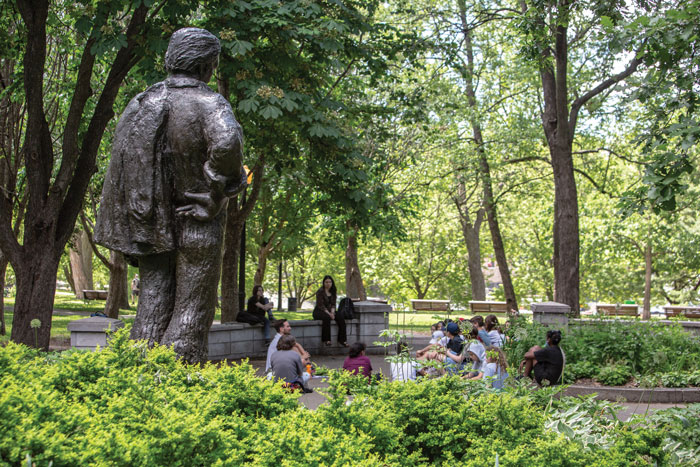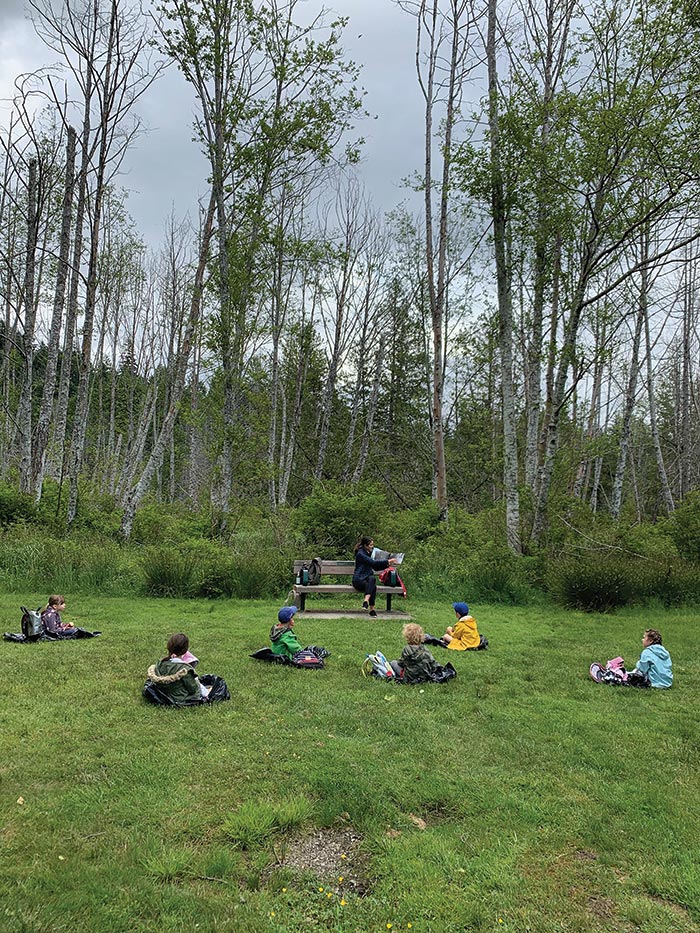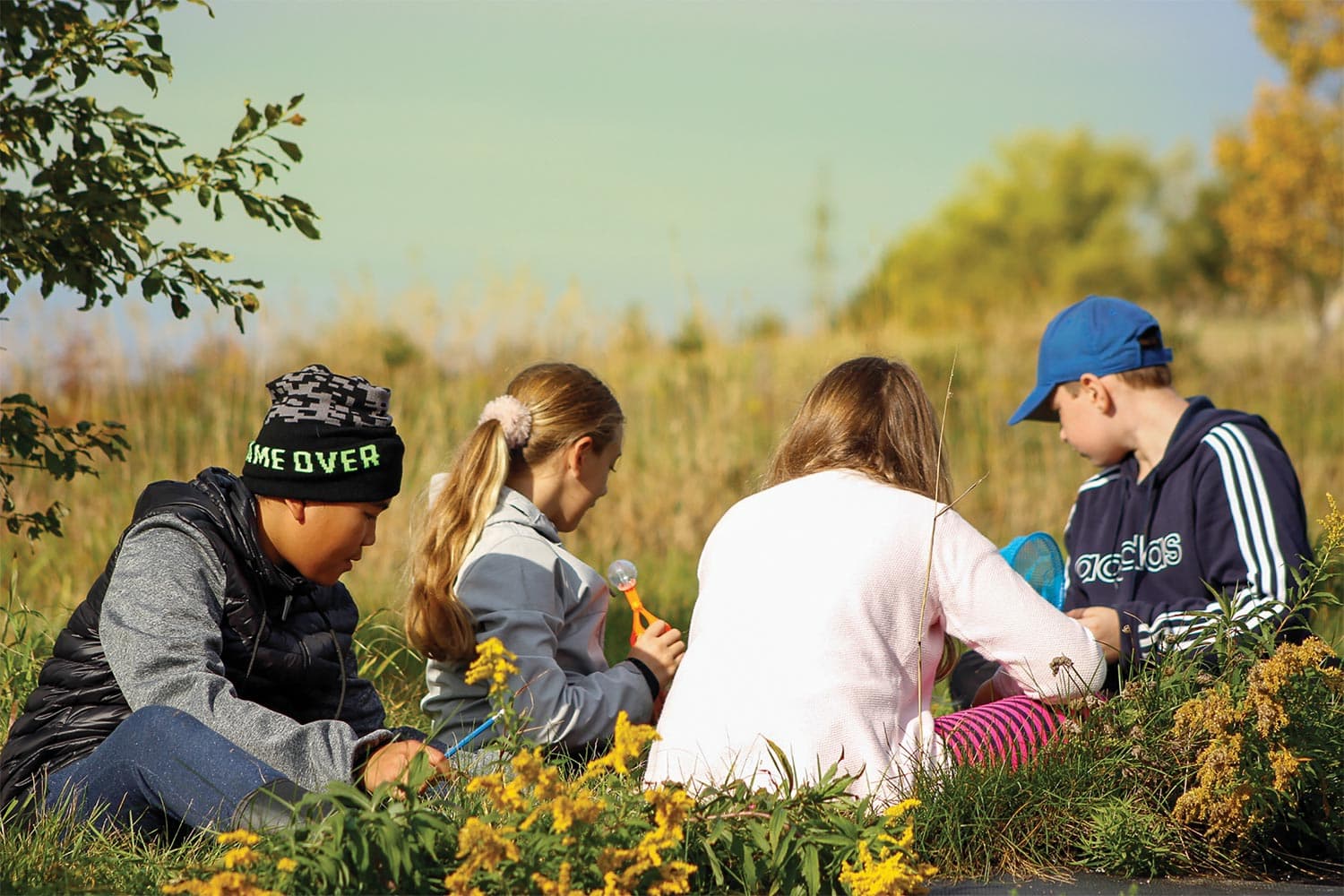Why Learning Outside Isn’t Going Anywhere
The pandemic made outdoor classes an educational hack, but it has benefits far beyond lowering viral transmission.
These students will visit the Le Semoir orchard over a three-year period.
In the spring of 1999, I was in Grade 6 at the tiny elementary school in Frelighsburg, QC, when the principal and local parents had an idea with the future in mind. On Friday afternoons during the fair-weather season, our entire class headed outside to plant trees on a big section of the hilly playground that was being converted back into a wild space.
It gave our squirmy, over-energized, 11-year-old bodies something physical to do at a point in the week when we were already imagining Saturday morning cartoons and playing in our backyards. It wasn’t all energy release, though; the weekly activity also taught us about the trees we were planting in what is now the town’s arboretum, used as an outdoor classroom for the elementary school.
Learning outside is clearly not new, but the practice got a major boost in many countries around the world in response to Covid-19, given the safety from infection and freedom from masks that the outdoors can provide. Outside, both kids and teachers can breathe a little easier and see each other’s faces. These settings also engage students in a more hands-on way that has lasting positive effects—from increased concentration to more deeply anchored learning, and potentially improved mental health—even after they return inside.

A Sherbrooke, QC, student reads outside.
An air of legitimacy
In the province of Québec, outdoor education has gained enough traction for Dr. Jean-Philippe Ayotte-Beaudet to be appointed to a new research chair on the subject at the Université de Sherbrooke in April 2022. Ayotte-Beaudet started researching outdoor science education for his masters thesis in 2013. He now collaborates on many projects looking into the benefits of outdoor learning for kids of all ages.
“Teachers are trying to connect more school learning with real life context,” says Ayotte-Beaudet. “I think that students and kids have been on different kinds of screens more and more, especially intensively during the pandemic… We focused on being indoors and on screens, and I think [outdoor learning is] a way to try and balance things out.”
He says there is some resistance to the format, though, stemming from aversion to the risk of a kid hurting themselves on a school’s watch. “In our society, we are always the target of zero risk,” he says. “But at the same time, I think we neglected the risks of not going outdoors—for physical developments, learning, and psychological benefits.”
Educators are rethinking how information is transmitted, by anchoring it in concrete experiences.
To shed light on those benefits, he’s currently involved with a study led by McGill University’s Dr. Marie-Claude Geoffroy, researching the psychological effects of outdoor school on a group of 2,000 Grade 6 students from lower income backgrounds, whose lives may have been especially disrupted by widening inequalities caused by the pandemic. This study will test the effectiveness of outdoor education as a strategy to improve mental health, the hope being that the results will encourage decision-makers to implement this type of curriculum based on empirical evidence.
The fact that the country now has a research chair on outdoor education also lends the practice needed legitimacy, as Ayotte-Beaudet points out that many teachers get criticized for replacing classroom curriculum with “just going outdoors to play.” Though outdoor learning does intrinsically help kids be more active, what educators are actually doing is rethinking how information is transmitted, by anchoring it in concrete experiences. And that’s not just the case for the more obvious arts and science classes—the format is being applied to subjects like math and languages too.
Ayotte-Beaudet speaks of students interacting with the world around them across subjects, like learning to add using the house numbers on a street instead of being taught static ways of counting while sitting at a desk. This method isn’t reserved for younger kids either, as teachers have taken high school students out to gather data about passing cars to learn about probability and statistics.

Some days, Montréal’s iconic Parc la Fontaine doubles as a classroom.
“If you have a specific task… you will be more able to talk about that to your family,” he points out. “And [kids] don’t realize it, but when you talk to someone else about something you learned, [you’re anchoring] more deeply your learning.”
In 2022, Ayotte-Beaudet’s team published a report based on surveys of more than 1,000 Québec preschool, elementary, and high school teachers, of subjects including math, arts, and science. The study found that over 95% of the participating educators observed significant improvements in students after the implementation of outdoor learning, including attention, learning, motivation, and overall well-being. Not to mention that over 90% of these same educators reported improvements to their own well-being. These shifts are consistent with the attention restoration theory, which posits that mental fatigue and concentration can be improved by being in nature.
Ayotte-Beaudet points out that this movement promoting outdoor education is sprouting up differently from other curriculum changes. It’s coming from the grassroots teachers themselves, rather than being imposed top-down by school boards and principals.
Hands-on benefits
In 2019, Arbre Évolution—a cooperative that focuses on reforesting and greening communities—worked with regional marketing and community development agency Visage Régionaux to create an organization called Le Semoir, which offers eco-education workshops for school classes. (Full disclosure, my cousin Simon Côté co-founded the co-op and works as its administrator.) Established throughout the province of Québec, Le Semoir is a logical extension of Arbre Évolution’s work, implementing a youth-centric educational focus deployed through theory classes, workshops, and outdoor learning for kids.
In Le Semoir’s mostly rural home region of Bas-Saint-Laurent, they’ve grown the Verger de l’évolution (“evolution orchard”) where students start planting fruit trees and other crops, like tomatoes, peppers and ginger, in Grade 4, and reap the fruits of their labour three years later. On a typical day in the orchard, students take a seat in the outdoor classroom equipped with a chalkboard, where they might learn about a plant’s life cycle before planting seedlings, and eventually tracking the plant’s growth through drawings.
Mental fatigue and concentration can be improved by being in nature.
Le Semoir’s activities aren’t restricted to rural areas, though. They work with schools in cities like Montréal, Québec City, and Sherbrooke, where students and their teachers participate in workshops like learning how to compost, foraging for edible urban plants, and exploring Indigenous approaches to medicine.
By being present in communities of all kinds, the organization is helping students rethink what a natural space looks like beyond tranquil forests and idyllic fields. This perspective shift is an important step in helping shape a generation that will need to fight for these spaces, care for them, and hopefully make them greener by redesigning cities and towns to be more resilient through the climate crisis. As heat increases each summer, there’s an immediate need to make our urban spaces more verdant, and cooler as a result.

Grade 4 students describe the soil in Le Semoir’s Verger de L’Évolution.
Thinking back to my own elementary school, I see the long-term benefits this sort of approach can have. In the arboretum my class helped plant, students now adopt a tree to learn about its leaves, and fruits or nuts. The planting exercise sowed the seed of my own interest in trees, teaching me how they should be planted in the spring or fall because cooler temperatures stimulate new root growth—knowledge I’ve since used when planting trees in my own backyard.
Le Semoir also believes in turning the benefits of outdoor learning into lifelong habits that protect the ecosystems we live in. To instill and inspire this passion, they don’t just drop into a school, give a workshop, and head on their way as an isolated event. Instead, their goal is to pass along knowledge to help everyone involved build long-term skills that can continue to be shared. Educators attend the workshops and activities alongside their students, so they have a learning experience of their own. Teachers can then become another link in the chain, weaving the content gleaned from workshops into writing or math exercises in the classroom, says Le Semoir coordinator Laurence Côté-Leduc.
Teachers can become another link in the chain, weaving content gleaned from workshops into exercises in the classroom.
Though Le Semoir took off in a major way province-wide during Covid—enrollment jumped from around 150 workshops in 2020 to about 350 in 2021—Côté-Leduc, sees its long-term value too: “Even post-pandemic, there’s always a need to get out from between the classroom’s four walls.” (Quotes from Côté-Leduc are translated from an interview conducted in French.)
Heading outside isn’t just beneficial for the kids either. Teachers have plenty to gain, as it changes the teaching relationship. Research chair Ayotte-Beaudet explains that teachers surveyed told researchers that in their classrooms they’re always telling students, “Don’t talk that loud and be more quiet.” He adds that the need to quiet students becomes less necessary outside, letting teachers focus on educating rather than discipline.
A coastal approach
Quebec isn’t the only province where teaching is getting an outdoor twist. In May 2022, the British Columbia School Trustees Association (BCSTA) wrote a letter to the provincial government requesting it provide funding to BC’s 60 school boards to help make outdoor learning more permanent. Since the province passed regulations mandating that Indigenous learning be included in the curriculum in 2017, the practice of using the outside as a classroom has only increased.
The BCSTA’s president, Carolyn Broady—who sits on the West Vancouver school board—sees these developing teaching approaches as setting the next generation on environmental career paths. She cites partnerships between schools and organizations like the federal Department of Fisheries and Oceans. In this setting, students receive instruction from scientists working on ocean protection, repairing local ecosystems, or the environmental impact of ocean pollution. Broady points out that students have gone on to enroll in related fields of post-secondary study after these learning experiences.
These teaching approaches set the next generation on environmental career paths.
She attests to the change outdoor learning has made in the community of Bowen Island, whose school is governed by the West Van school board. Since 2012, elementary-age kids at Bowen Island Community School have been learning about things like stream-keeping and land stewardship. “Often, it’s the classroom teacher who is passionate about something like this,” highlights Broady, confirming Ayotte-Beaudet’s observations from across the country. “That starts [outdoor education] in a school district, and [it] grows and grows from there.”
Bowen Island’s outdoor learning program reaches beyond nature and into technology, as kids between kindergarten and Grade 3 have learned to create QR (quick response) codes that have been placed on panels beside trees and plants on the school grounds. Visitors scan these codes and tap on the links they generate, which lead to videos of the students describing the plants and explaining facts like whether the species is native. “It’s tying that science bit in—the technology built into the natural, place-based stuff,” says Broady. Once the QR codes were set up, students led their parents through the plant circuit they’d created to pass on the knowledge they’d organized.

Outdoor story time on BC’s Bowen Island
Broady also explains that the effects of kids being more aware of their surrounding environments extends beyond the confines of curriculum. After kids in her school district participated in a West Vancouver community garbage cleanup, the school board received supportive feedback letters from retirees and seniors.
This anecdote reminds me of how simple actions can have impacts beyond their immediate goals. The trees my class planted 23 years ago are now a flourishing green space for locals and visitors to enjoy a shady, leafy spot. And the kids now learning outside will take the perspectives and skills they gain into their adult lives.
Le Semoir’s Côté-Leduc points out that today’s kids are not only the people who will experience the environmental consequences of previous generations’ actions. They’re also “the decision-makers of the future.” With the growth in outdoor learning, we can hope some of these future society-shapers will make choices informed by deep connections to place and nature.
Print Issue: Summer/Fall 2022
Print Title: Take It Outside
